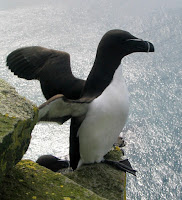RAZORBILL
RAZORBILL – (Alca torda) – (See images below)
DESCRIPTION: The Razorbill is all black except for its under parts, which are white. During breeding season it has a thin white line from the eye to the base of the bill, and another white line across the otherwise black bill. The bill is thick and long, The feet are dark grey. Non-breeding adults have a white throat. Sexes are similar. Bird measures approximately 40 cm (16 inches) long.
VOICE: https://www.xeno-canto.org/species/Alca-torda
NAME: This bird owes its English name to the sharp edges of its bill. The Latin genus name ‘Alca’ comes from an Icelandic and Swedish word to mean ‘auk’, and ‘torda’ also comes from a Swedish word that means ‘auk’.
HABITAT: Rocky coastal cliffs and islands.
DIET: Feed on fish such as sand eel and can dive as deep as 120 meters (390 feet).
NESTING: Nests in colonies on cliffs with other seabirds species. Nests hidden in rock crevices. Mate for life. One light beige egg is laid, incubated by both parents. Chicks fed by both parents.
DISTRIBUTION: Main breeding range is in northern Europe, mostly around Iceland. Has expanded its breeding locations in other maritime provinces such as around Cape Breton. Winters along ice free coasts of Northern Europe and eastern Canada, and North Atlantic, going as far south as off northern Africa.
Distribution map: https://en.wikipedia.org/wiki/Razorbill#/media/File:Alca_torda_map.svg
ON PEI: Does not breed on Prince Edward Island. Occurrences vary from uncommon to common in the fall.
CONSERVATION: Listed as ‘near threatened’ by the IUCN due to a rapid decrease in its main population (Europe), notably at nesting sites in Iceland. An important factor would be a crash of the sand eel population around Iceland. Vulnerable to climate change, which brings more severe storms that can cause high mortality rates in those seabirds.
NOTES: The razorbill is a North Atlantic seabird that is part of the same family as the auks, puffins and guillemots, and is the closest living relative of the extinct Great Auk. These are birds that can easily swim underwater as if they would fly, but are clumsy when walking on land. This species looks like a penguin but is not related to it.
Penguins: Because of its physical similarity to a small penguin, the razorbill is called ‘Petit Pingouin’ in French, although it is not part of the same family as the penguin, nor even the same order. However its family shares some behavioral traits with the penguins, such as standing erect, having short wings and mainly using them to propel itself in the water. They also walk clumsily on land. This similarity between penguins and auks is called ‘convergent evolution’.
SIMILAR SPECIES: Common Murre, Thick-billed Murre
REFERENCES: http://www.npolar.no/en/species/razorbill.html (Norwegian Polar Institute)
https://animaldiversity.org/accounts/Alca_torda/ (University of Michigan)
https://www.audubon.org/field-guide/bird/razorbill
https://en.wikipedia.org/wiki/Razorbill
https://www.allaboutbirds.org/guide/Razorbill/lifehistory
http://www.nhptv.org/natureworks/razorbill.htm (New Hampshire PBS)
DESCRIPTION: The Razorbill is all black except for its under parts, which are white. During breeding season it has a thin white line from the eye to the base of the bill, and another white line across the otherwise black bill. The bill is thick and long, The feet are dark grey. Non-breeding adults have a white throat. Sexes are similar. Bird measures approximately 40 cm (16 inches) long.
VOICE: https://www.xeno-canto.org/species/Alca-torda
NAME: This bird owes its English name to the sharp edges of its bill. The Latin genus name ‘Alca’ comes from an Icelandic and Swedish word to mean ‘auk’, and ‘torda’ also comes from a Swedish word that means ‘auk’.
HABITAT: Rocky coastal cliffs and islands.
DIET: Feed on fish such as sand eel and can dive as deep as 120 meters (390 feet).
NESTING: Nests in colonies on cliffs with other seabirds species. Nests hidden in rock crevices. Mate for life. One light beige egg is laid, incubated by both parents. Chicks fed by both parents.
DISTRIBUTION: Main breeding range is in northern Europe, mostly around Iceland. Has expanded its breeding locations in other maritime provinces such as around Cape Breton. Winters along ice free coasts of Northern Europe and eastern Canada, and North Atlantic, going as far south as off northern Africa.
Distribution map: https://en.wikipedia.org/wiki/Razorbill#/media/File:Alca_torda_map.svg
ON PEI: Does not breed on Prince Edward Island. Occurrences vary from uncommon to common in the fall.
CONSERVATION: Listed as ‘near threatened’ by the IUCN due to a rapid decrease in its main population (Europe), notably at nesting sites in Iceland. An important factor would be a crash of the sand eel population around Iceland. Vulnerable to climate change, which brings more severe storms that can cause high mortality rates in those seabirds.
NOTES: The razorbill is a North Atlantic seabird that is part of the same family as the auks, puffins and guillemots, and is the closest living relative of the extinct Great Auk. These are birds that can easily swim underwater as if they would fly, but are clumsy when walking on land. This species looks like a penguin but is not related to it.
Penguins: Because of its physical similarity to a small penguin, the razorbill is called ‘Petit Pingouin’ in French, although it is not part of the same family as the penguin, nor even the same order. However its family shares some behavioral traits with the penguins, such as standing erect, having short wings and mainly using them to propel itself in the water. They also walk clumsily on land. This similarity between penguins and auks is called ‘convergent evolution’.
SIMILAR SPECIES: Common Murre, Thick-billed Murre
REFERENCES: http://www.npolar.no/en/species/razorbill.html (Norwegian Polar Institute)
https://animaldiversity.org/accounts/Alca_torda/ (University of Michigan)
https://www.audubon.org/field-guide/bird/razorbill
https://en.wikipedia.org/wiki/Razorbill
https://www.allaboutbirds.org/guide/Razorbill/lifehistory
http://www.nhptv.org/natureworks/razorbill.htm (New Hampshire PBS)
 |
| Razorbill, Norway, Martin Mecnarowski |
 |
| Razorbill holding fish, by Harald Olsen |
 |
| Razorbill sunning, by Helene Grenier |
 |
| Razorbill, Iceland, by Gsd97jks |
 |
| Razorbill with shanny, by D.L. Jameson |
 |
| Razorbills, Isle of May, Magnus Hagdorn |